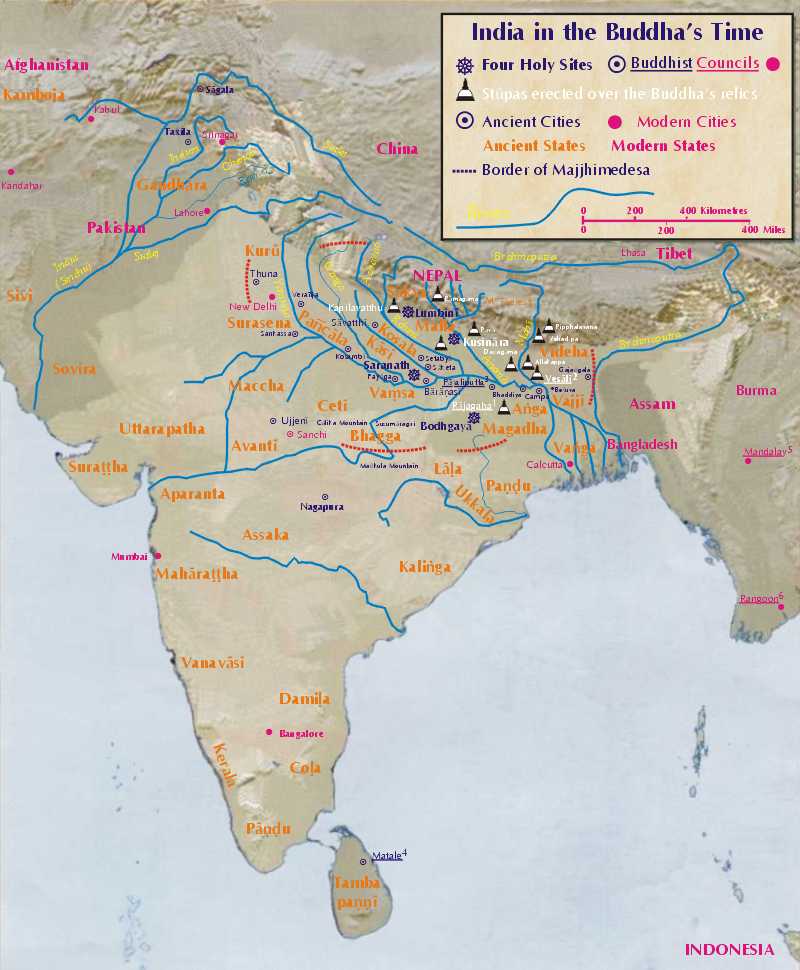Acknowledgements Some details about Buddhist holy places from indiatravel.com, which also gives distances from major cities to aid location. The original map, which I edited to remove roads, state boundaries, and railways, was released to the public by the Central Intelligence Agency. | Disclaimer Some information on this map may be inaccurate due to the difficulty of mixing information from various sources. I will be grateful to know of any serious errors or minor oversights so that I can gradually improve it for future editions. |
The Sixteen NationsThese sixteen nations at the time of the Buddha are named in the Visākhā Sutta of the Uposatha Vagga, in the Book of the Eights 1. Visākhā was born in the city of Bhaddiya, in the country
of Anga, which seems to have been part of the Magadha kingdom.
2. Magadha was the kingdom of Bimbisāra and his son, Ajātasattu.
3. Bārānasi was the capital city of Kāsī, a region famous for its silk.
4. Kosala was ruled by Pasenadi from his capital Sāvatthī. The Buddha spent many Rains Retreats in the Jeta grove near Sāvatthī donated by Anāthapindika.
5. The Vajjī
kingdom had its capital at Vesālī. The Buddha spent his final Rains Retreat at Beluva near Vesālī.
6. The Mallas had their capital city at Kusināra, where the Buddha passed away.
7. Cetī lay to the south-west of Kāsī
8. Vanga was the Ganges delta region
9. The Kurū kingdom was the region north-east of of Delhi. It was here that the Buddha preached the famous Satipatthāna and Kālāma suttas.
10. Pañcāla was west of Kāsī.
11.
Maccha was to the west of Cetī.
12. Sūrasena was to the west of what is now Delhi
13. Assaka was the region where the Ajanta caves are now found
14. Avantī was south-west of Cetī
15. Gandhāra was famed for its university of Takkasila (Taxila). The name Takkasila means stone-cutting, and this region became famous for its high quality stone Buddha images.
16. Kamboja
was beyond the Hindu Kush mountins in what is now Afghanistan. Kamboja was famous for its fine horses. | The Four Holy SitesThe four holiest places for Buddhists are the sites where the four main events of the Buddha’s life took place: Lumbinī,
where the bodhisatta was born; Bodhgaya, where he gained Enlightenment; Saranath, where he gave is first discourse; and Kusināra, where he attained parinibbāna. The Ten Stūpas1. King Ajātasattu of Magadha erected a stūpa over the Buddha’s
relics at Rājagaha.
2. The Licchavīs of Vesālī erected a stūpa at Vesālī
3. The Sakyas of Kapilavatthu erected a stūpa at Kapilavatthu,
4. The Bulis of Allakappa erected a stūpa at Allakappa,
5. The Koliyās of Rāmagāma erected a stūpa at Rāmagāma
6. The Vetthadīpa brahmin erected a stūpa at Vetthadīpa.
7. The Mallas of Pāvā erected a stūpa at Pāvā
8. The Mallas of Kusināra erected a stūpa at Kusināra 9. The brahmin Dona who divided the relics fairly into eight portions erected a stūpa over the urn that was used to preserve the relics. 10. The Moriyās of Pippalivana erected a stūpa over the ashes of the funeral pyere at Pippalivana, So it came about that there were eight stūpas for the relics, a ninth for the urn, and a tenth for the ashes. The Six Buddhist Councils1. At Rājagaha, three months after the Buddha’s parinibbāna in 544 B.C.
2. At Vesālī, 100 years after the Buddha’s parinbbāna.
3. At Pātaliputta, in 326 BC.
4. At Matale, Tambapanni (Sri Lanka) in 29 B.C.
5. At Mandalay, Burma 1871 A.D.
6. At Rangoon, Burma from 1954 to 1956, concluding 2,500 years after the parinibbāna. |

